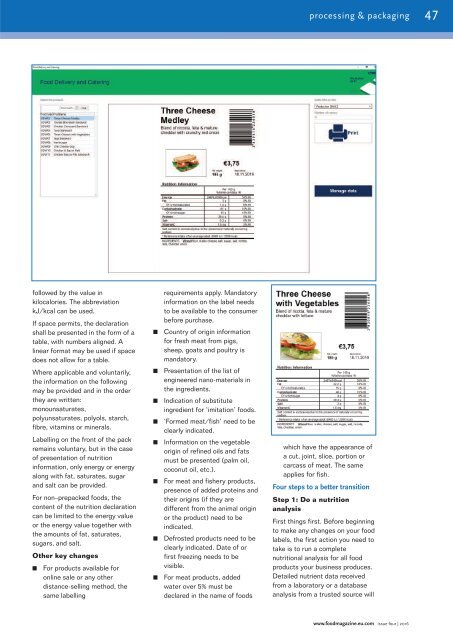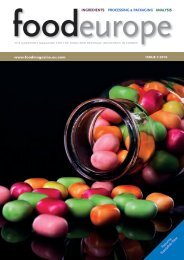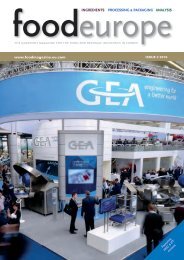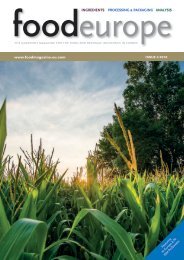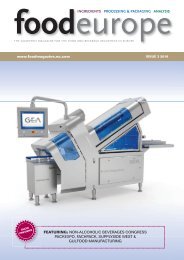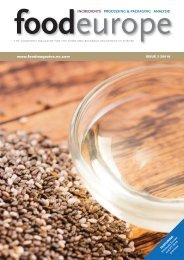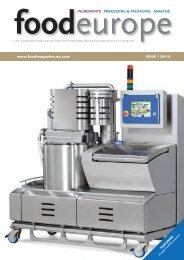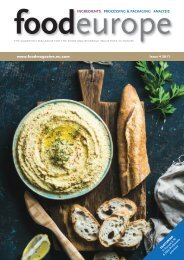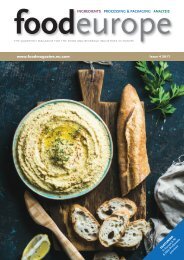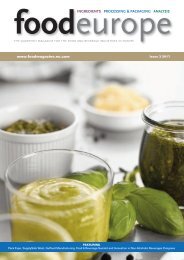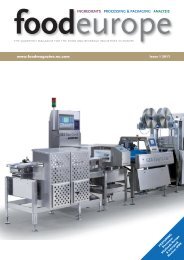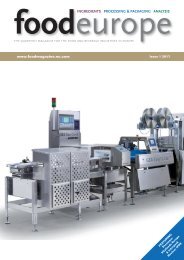FoodEurope Issue 4 2016
You also want an ePaper? Increase the reach of your titles
YUMPU automatically turns print PDFs into web optimized ePapers that Google loves.
processing & packaging 47<br />
followed by the value in<br />
kilocalories. The abbreviation<br />
kJ/kcal can be used.<br />
If space permits, the declaration<br />
shall be presented in the form of a<br />
table, with numbers aligned. A<br />
linear format may be used if space<br />
does not allow for a table.<br />
Where applicable and voluntarily,<br />
the information on the following<br />
may be provided and in the order<br />
they are written:<br />
monounsaturates,<br />
polyunsaturates, polyols, starch,<br />
fibre, vitamins or minerals.<br />
Labelling on the front of the pack<br />
remains voluntary, but in the case<br />
of presentation of nutrition<br />
information, only energy or energy<br />
along with fat, saturates, sugar<br />
and salt can be provided.<br />
For non–prepacked foods, the<br />
content of the nutrition declaration<br />
can be limited to the energy value<br />
or the energy value together with<br />
the amounts of fat, saturates,<br />
sugars, and salt.<br />
Other key changes<br />
n For products available for<br />
online sale or any other<br />
distance-selling method, the<br />
same labelling<br />
requirements apply. Mandatory<br />
information on the label needs<br />
to be available to the consumer<br />
before purchase.<br />
n Country of origin information<br />
for fresh meat from pigs,<br />
sheep, goats and poultry is<br />
mandatory.<br />
n Presentation of the list of<br />
engineered nano-materials in<br />
the ingredients.<br />
n Indication of substitute<br />
ingredient for ‘imitation’ foods.<br />
n ‘Formed meat/fish’ need to be<br />
clearly indicated.<br />
n Information on the vegetable<br />
origin of refined oils and fats<br />
must be presented (palm oil,<br />
coconut oil, etc.).<br />
n For meat and fishery products,<br />
presence of added proteins and<br />
their origins (if they are<br />
different from the animal origin<br />
or the product) need to be<br />
indicated.<br />
n Defrosted products need to be<br />
clearly indicated. Date of or<br />
first freezing needs to be<br />
visible.<br />
n For meat products, added<br />
water over 5% must be<br />
declared in the name of foods<br />
which have the appearance of<br />
a cut, joint, slice, portion or<br />
carcass of meat. The same<br />
applies for fish.<br />
Four steps to a better transition<br />
Step 1: Do a nutrition<br />
analysis<br />
First things first. Before beginning<br />
to make any changes on your food<br />
labels, the first action you need to<br />
take is to run a complete<br />
nutritional analysis for all food<br />
products your business produces.<br />
Detailed nutrient data received<br />
from a laboratory or a database<br />
analysis from a trusted source will<br />
www.foodmagazine.eu.com issue four | <strong>2016</strong>


